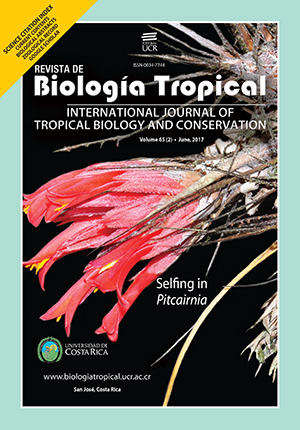Abstract
In ecology, the success of parasitoid-host interactions is determined by the behavior of seeking, recognition, attack and defense deployed by the participants in the interaction. Our study aimed to understand the behavioral patterns between parasitoid phorids and their host Atta colombica from a forest fragment of Córdoba department, Colombia. We observed three nests of Atta colombica, from December 2013 to Januray 2015 (including dry and rainy seasons), for a total effort of 189 hours. We observed Phorids, their attacks to ants and collected their loads; we also considered differences in the way the parasitoids attacked and observed the microhabitat they preferred. A total of 52 individuals of Eibesfeldtphora attae and 54 of Apocephalus colombicus were collected. Apparently there was no preference for the size of the ants that were attacked by phorids, but larger loads were selected to land on them. When the ants responded to the phorid attack, they used individual defenses (adopting positions or increasing their speed) or grupal defenses (closer ants attacking the phorid). Parasitoid phorids have specialized their behavior, in order to ensure a successful attack on their host, who responded by modifying its behavior, according to the attacker (parasitoid).References
Bragança, M. A., Della Lucia, T., & Tonhasca Jr, A. (2003). First record of phorid parasitoids (Diptera: Phoridae) of the leaf-cutting ant Atta bisphaerica Forel (Hymenoptera: Formicidae). Neotropical Entomology, 32(1), 169-171.
Bragança, M. A., Tonhasca, Jr. A., & Della Lucia, T. (2009). Biological and behavioral characteristics of Neodohrniphora elongata Brown (Diptera, Phoridae), a parasitic fly of the leaf-cutting ant Atta sexdens rubropilosa Forel (Hymenoptera, Formicidae). Revista Brasileira de Entomologia, 53(4), 600-606.
Bragança, M. A., Tonhasca Jr, A., & Moreira, D. (2002). Parasitism characteristics of two phorid fly species in relation to their host, the leaf-cutting ant Atta laevigata (Smith) (Hymenoptera: Formicidae). Neotropical Entomology, 31(2), 241-244.
Brown, B. V. (1997). Revision of the Apocephalus attophilus-group of ant-decapitating flies (Diptera: Phoridae). Contributions in Science, 468, 1-60.
Brown, B. V., Borkent, A., Cumming, J. M., Wood, D. M., Woodley, N. E., & Zumbado-Arrieta, M. A. (2010). Manual of Central American Diptera (Vol. 2). Ottawa: NRC Research Press.
Da Silva Gomes, D. (2011). Ecologia de parasitóides (Diptera: Phoridae) de Atta robusta Borgmeier, 1939 (Hymenoptera: Formicidae) em ambiente de restinga (Tesis de maestría). Universidade Federal Rural do Rio de Janeiro, Brazil. Recuperada de http://www.ufrrj.br/posgrad/cpgba/teses.html
Eibl-Eibesfeldt, V. J. (1967). On the guarding of leafcutter ants by minima-workers. Naturwissenschaften, 54(13), 346-346.
Elizalde, L. (2009). Biogeografía y comunidades de fóridos parasitoides de hormigas cortadoras de hojas: diversidad del sistema y partición del recurso hospedador (Tesis doctoral inédita). Universidad Nacional de Quilmes, Bernal, Buenos Aires, Argentina.
Elizalde, L., & Folgarait, P. J. (2010). Host diversity and environmental variables as determinants of the species richness of the parasitoids of leaf‐cutting ants. Journal of Biogeography, 37(12), 2305-2316.
Elizalde, L., & Folgarait, P. J. (2011). Biological attributes of Argentinian phorid parasitoids (Insecta: Diptera: Phoridae) of leaf-cutting ants, Acromyrmex and Atta. Journal of Natural History, 45(43-44), 2701-2723.
Feener, Jr, D. H., & Brown, B. V. (1997). Diptera as parasitoids. Annual Review of Entomology, 42(1), 73-97.
Feener, Jr, D. H., & Moss, K. A. (1990). Defense against parasites by hitchhikers in leaf-cutting ants: A quantitative assessment. Behavioral Ecology and Sociobiology, 26(1), 17-29.
Fellowes, M., & Godfray, H. (2000). The evolutionary ecology of resistance to parasitoids by Drosophila. Heredity, 84(1), 1-8.
Folgarait, P. J. (2013). Leaf-cutter ant parasitoids: Current knowledge. Psyche: A Journal of Entomology, Article ID 539780, 10 pages.
Gazal, V., Bailez, O., & Viana-Bailez, A. M. (2009). Mechanism of host recognition in “Neodohrniphora elongate” (Brown) (Diptera: Phoridae). Animal Behaviour, 78(5), 1177-1182.
Gomes, D. S., Elizalde, L., & Queiroz, J. M. (2013). Parasitoids of the endangered leaf-cutter ant Atta robusta Borgmeier in urban and natural areas. Revista Brasileira De Entomologia, 57(3), 335-339.
Holdridge, L. R. (1987). Ecología basada en zonas de vida. San José, Costa Rica: Instituto Interamericano de Cooperación para la Agricultura.
Hölldobler, B., & Wilson, E. O. (1990). The ants. Harvard University Press.
Lapchin, L., & Guillemaud, T. (2005). Asymmetry in host and parasitoid diffuse coevolution: When the red queen has to keep a finger in more than one pie. Frontiers in Zoology, 2(4), 4.
Mathis, K. A., & Philpott, S. M. (2011). Current understanding and future prospects of host selection, acceptance, discrimination, and regulation of phorid fly parasitoids that attack ants. Psyche: A Journal of Entomology, Article ID 895424, 9 pages.
Palencia, G., Mercado, T., & Combatt, E. (2006). Estudio agroclimático del departamento de Córdoba. Montería, Colombia, Universidad de Córdoba.
Rodríguez del Bosque, L., & Arredondo-Bernal, H. (2007). Teoría y aplicación del control biológico. México, DF.: Sociedad Mexicana de Control Biológico.
Roitberg, B., Boivin, G., & Vet, L. E. M. (2001). Fitness, parasitoids, and biological control: An opinion. The Canadian Entomologist, 133(03), 429-438.
Santos, A., & Quicke, D. L. (2011). Large‐scale diversity patterns of parasitoid insects. Entomological Science, 14(4), 371-382.
Uribe, S. (2013). Fóridos (Díptera: Phoridae) asociados al hábitat de hormigas cortadoras de hojas (Atta cephalotes y Acromyrmex octospinosus) y sus patrones de localización en un bosque seco tropical andino (Tesis de maestría). Universidad Nacional de Colombia, Sede Medellín. Recuperada de http://www.bdigital.unal.edu.co/9278/
Uribe, S., Brown, B. V., Bragança, M. A., Queiroz, J. M., & Nogueira, C. A. (2014). New species of Eibesfeldtphora Disney (Diptera: Phoridae) and a new key to the genus. Zootaxa, 3814(3), 443-450.
Wetterer, J. K. (1999). Ecology and evolution of worker size-distribution in leaf-cutting ants (Atta spp. and Acromyrmex spp.). Sociobiology, 34, 119-144.
Comments

This work is licensed under a Creative Commons Attribution 4.0 International License.
Copyright (c) 2017 Revista de Biología Tropical






